Posts Tagged ‘Particulate Matter’
Study: LAX Pollutes More Than Half of SoCal Freeways
 Researchers at the Keck School of Medicine and the University of Southern California have just published a report in the American Chemical Society's Environmental Science & Technology journal that shows air traffic from Los Angeles International Airport is responsible for more air pollution than half of all the city's notoriously congested freeways with a plume extending at least 10 miles downwind.
Researchers at the Keck School of Medicine and the University of Southern California have just published a report in the American Chemical Society's Environmental Science & Technology journal that shows air traffic from Los Angeles International Airport is responsible for more air pollution than half of all the city's notoriously congested freeways with a plume extending at least 10 miles downwind.
LAX is the world's sixth largest airport, with 40-60 take-offs an hour. DFW averages 46 according to the airport's own website.
USC Scientists spent a month driving around the LA airport taking air samples for Particulate Mater pollution and found that downwind communities had twice the routine background level of PM in the city. Nine miles out, they found PM levels five times higher than background. Two miles from LAX, PM levels were almost 10 times higher. For comparison's sake, that's equivalent to 174 to 491 miles of freeway traffic. The entire area of Los Angeles County has a total of about 930 miles of freeways. Based on their calculations, scientists concluded that within the area they found to have elevated pollution from the airport, automobiles contributed less than 5 percent of the PN levels. “Therefore, the LAX should be considered one of the most important sources of PN in Los Angeles,” concluded the ACS piece
Why is that a public health concern?
"Ultrafine particles, which form from condensation of hot exhaust vapors, are of particular concern because they deposit deeply into the lungs and can enter the bloodstream. The oxidative stress and resulting inflammation appear to play a role in the development of atherosclerosis (blocked arteries) and can make other health conditions worse, especially for people with existing cardiac or lung conditions including asthma."
As far as we know there's been no study of PM pollution from DFW Airport – no federal highways dollars at stake – but this one from California should prompt one.
Air Pollution is “an overlooked risk factor” for Heart Disease
 Over the last decade we've seen plenty of studies linking air pollution, and specifically Particulate Matter, or soot pollution, to heart disease and attacks. Now Dr. François Reeves,a Canandian cardiologist has a new book "Planet Heart: How an Unhealthy Environment Leads to Heart Disease," that puts those studies in context.
Over the last decade we've seen plenty of studies linking air pollution, and specifically Particulate Matter, or soot pollution, to heart disease and attacks. Now Dr. François Reeves,a Canandian cardiologist has a new book "Planet Heart: How an Unhealthy Environment Leads to Heart Disease," that puts those studies in context.
“You can sum it up like this: more pollution, more major adverse cardiac events. Pollution of the city is as toxic as cigarette smoke. It has different stuff in it, but the difference is that with pollution, you get it all through your life, from your birth to your death. If you live in a polluted milieu, as soon as you’re a baby you’ll take it in through every breath.”
Reeves' interest as a cardiologist in air pollution issues was triggered by a 2008 World Health Organization report that tracked mortality rates for cardiovascular disease in European countries. In nations with relatively clean air like Norway or even France, the levels were approximately 25 to 70 per 100,000 men. In Russia and the Ukraine it was 600-750 per 100,000. “I was blown away by those numbers,” Reeves says. “We know the classical and well-demonstrated risk factors for heart disease, like smoking and obesity and inactivity. But that’s when I realized the environment has a huge impact."
Just like lead, and benzene, and dioxin, and so many other kinds of pollution, there appears to be no "safe level" of exposure to PM pollution. Any amount is capable of doing some harm, and the more you're exposed, the more harm is likely to happen. That's why fence-line communities are particularly vulnerable to higher rates of illness. In DFW, where PM levels are considered under control, there are still lots of hot spots for the pollutant. If you live downwind of the Midlothian cement plants, you're inhaling a lot of soot. the closer you live – Cedar Hill, South Grand Prairie, South Arlington, Mansfield – the more soot you're inhaling.
In his new book Reeves gives a list of heart-healthy things an individual can do to reduce their risk of heart disease, including increased bike riding, more public transit, or walking and weaning yourself off of internal combustion engines with electric cars and hybrids. “Look at everything you’re doing to minimize your footprint and do whatever you can to have an impact on global footprint,” Reeves says,
But he recognizes the limits of this kind of advice if a person is living in a smoggy city or region and offers overarching policy advice for officials. Cities and governments must continue their efforts to be green, if only out of their own self-interest.
If those governments need any convincing, Brauer points to a financial argument: fewer health problems mean less strain on the public system. “If you improve air quality, everybody benefits,” he says. “It’s really, really cost-effective.
“Another Study Links Air Pollution to Autism” x4
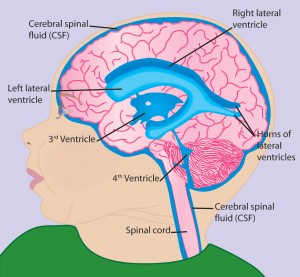 One of the areas of environmental health research that's producing almost monthly results is the varied and pernicious adverse human health effects of tiny particulate matter, or soot.
One of the areas of environmental health research that's producing almost monthly results is the varied and pernicious adverse human health effects of tiny particulate matter, or soot.
Once only blamed for respiratory problems and then heart attacks, it's now associated with a high blood pressure, strokes, immune system damage and a wide range of neurological diseases and conditions, including IQ loss, Parkinson's, and early dementia. That's because the particles are so small they pass through the lining of the lung and into a person's blood stream and can end up anywhere, including the brain.
Late last week saw the latest study to link PM pollution to autism. It was the fourth major study to do so in the last two years alone. But unlike the previous three, which found an epidemiological association between exposure to PM and the rate of autism in a community, this one may actually begin to explain the physiology of how PM attacks the brain:
"Researchers at the American Association for the Advancement of Sciences (AAAS) annual meeting in Chicago recently detailed the impact that constant exposure to air pollution may have on the developing brain. According to the panel, a series of mouse models have suggested that constant inhalation of air pollution may lead to enlargement of the brain’s ventricles – a hallmark of neurodevelopmental disorders such as schizophrenia and autism."
A brain's ventricular system is a set of four structures containing cerebrospinal fluid (CSF). It's continuous with the central canal of the spinal cord. Cerebrospinal fluid helps to protect the brain, keep it clean and boost its energy. When these ventricles are enlarged, it often indicates a damaged central nervous system. Dr. Deborah Cory-Slechta of the University of Rochester School of Medicine says that's what they found after exposing mice to PM pollution
“When the brain ventricles are too big, it pushes on the rest of the tissue,” Cory-Slectha said. “Also, you have these tracks of what’s called ‘white matter.’ And they cross over the brain; they connect the two hemispheres. And in these mice, those are either missing, or never developed, or died. We don’t know which, but a lot of that is missing, and that too is very characteristic of autism and schizophrenia.”
Ventriculomegaly – the enlargement of the ventricles – is also associated with a range of other brain diseases, such as bipolar disorder and Alzheimer’s disease, as well as a number of birth defects in children. Cory-Slectha noted that this brain damage was largely seen in the male rodents – an interesting finding given that both autism and schizophrenia are mainly male-oriented conditions.
“And part of that that is so interesting is both autism and schizophrenia, not only are they primarily in males, but the rates of those have been going up,” Cory-Slectha said. “And yet nobody can really ever explain why. [They say] it’s the diagnoses, etc. Well you know, air pollution has also gotten worse in some places, and you are exposed to it your entire life. So now we have the [epidemiological research] and we have the animal studies [to support that].”
She's right. We already have very strong correlations between levels of PM pollution and autism that this animal toxicology study now dovetails. Last June, the National Institute of Environmental Health Sciences published a study showing that women living in high air pollution areas while pregnant are up to twice as likely to have a child with autism as those living in less polluted areas.
In March of last year, researches at UCLA published a study showing the more Ozone and Particulate Matter pollution a baby in the womb is exposed to, the more likely he or she will be born with autism. It was the largest study of its kind to date.
In November of 2012, another UCLA study found that children who are born and live their first year closer to major freeways also suffer a significantly elevated risk of autism.
Scientists now know that there is no safe level of exposure to tiny PM pollution, called PM 2.5 because it's 2.5 microns or smaller. Any amount is capable of harming someone, especially if that someone is a child, senior citizen, or already ha health problems. And yet, regulatory agencies pretend this science doesn't exist – otherwise it would be very hard to issue permits for tons of new PM pollution, which they do almost every week.
There's been an explosion in the rate of autism in the US over the last 30 years. Could air pollution account for at least a sizable portion of that increase? The science is saying yes.
Study: 2 Million Air Pollution Deaths Annually Worldwide, 77,000 in US
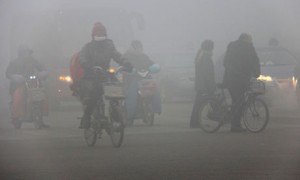 We're a bit behind the curve in reporting on this, but scientists at the University of North Carolina just published a study in "Environmetnal Research Letters" that estimates Particulate Matter and Ozone pollution in the air is responsible for approximately 2.2 million deaths worldwide every year.
We're a bit behind the curve in reporting on this, but scientists at the University of North Carolina just published a study in "Environmetnal Research Letters" that estimates Particulate Matter and Ozone pollution in the air is responsible for approximately 2.2 million deaths worldwide every year.
Long-timers already know about how insidious Particulate Matter can be, but this only chronicles the hardcore fatal respiratory and cardiovascular impacts, concluding the tiny particles of soot cause at least 2.1 million deaths every year while ozone pollution shortens another 500,000 lives.
"East Asia," aka China, accounts for fully have of both those figures. India for another third. In North America, the casualties include 43,000 premature deaths from PM pollution and 33,000 from ozone.
Jason West, co-author of the study said: "Outdoor air pollution is an important problem and among the most important environmental risk factors for health."
Although alarming, these numbers are all underestimates of the health impacts of both of these pollutants, since they exclude anything other than fatalities. Besides making it harder to breathe, PM pollution has been linked to brain disorders and immune system disruptions.
Cuts in Methane and PM Pollution Can Slow Climate Change
 In an opinion piece in The Daily Climate, Michael MacCraken, the chief scientist for the DC-based Climate Institute advocates an end-run strategy to avoid the political logjam over large CO2 cuts as a way to fight global warming. He suggests concentrating on reducing Methane and Particulate Matter pollution as a way to "appreciably slow the rate of warming over the next several decades." He cites an earlier UN study that concluded:
In an opinion piece in The Daily Climate, Michael MacCraken, the chief scientist for the DC-based Climate Institute advocates an end-run strategy to avoid the political logjam over large CO2 cuts as a way to fight global warming. He suggests concentrating on reducing Methane and Particulate Matter pollution as a way to "appreciably slow the rate of warming over the next several decades." He cites an earlier UN study that concluded:
"…a moderately aggressive international emissions control program focused on the short-lived compounds could roughly halve the projected warming between the present and 2050. While slowing the warming through this approach might seem to also offer additional time for cutting CO2 emissions, this is not the case. Instead, these actions are more appropriately viewed as partially making up for earlier policy delays.
For the United States to do its share, aggressive limits on CO2 emissions must be complemented by aggressive limits of emissions of short-lived species. In particular, the Environmental Protection Agency will need to be more aggressive in cutting short-lived emissions, particularly of methane from the oil and gas industry, and making its voluntary methane and black carbon programs mandatory.
With climate change so far along, the question now is no longer whether impacts can be avoided, but rather how bad they will become. What we do with respect to both mitigation and adaptation will control that outcome. The longer we wait, the worse the impacts and sharper the required energy transition."
While methane gradually breaks down in the atmosphere, forming carbon dioxide, it has 100 times the warming potential of carbon dioxide for the first 20 years it’s exposed to the environment. A study by Cornell University Environmental Biology Professor Robert Howarth found between four and eight percent of the methane produced by a fracking well is leaked into the atmosphere during the well’s lifetime. For all the immediate environmental benefits of natural gas, the methods used for its extraction could create a larger greenhouse footprint than oil or coal over time.
EPA is considering a new national PM pollution standard because of its public health impacts and should use the opportunity to win deeper cuts that offer so many "co-benefits." Every reduction in soot is now doubly important. Cars, cement kilns, coal plants, and just about any industrial boiler or furnace spews out PM. They all need to be targeted as part of a larger effort to bring this kind of pollution under better control.
This impact on global warming is also one more reason why Dallas residents should be demanding that the city incorporate some kind of "off-sets" policy regarding new oil and gas air pollution as part of a new City drilling ordinance. Not only can it hep reduce smog and some of the toxins released by the drilling and processing of natural gas; it can also provide some needed help for climate change at a time when the city is just squeaking by its own greenhouse gas reduction goals.
Does Pollution Discriminate?
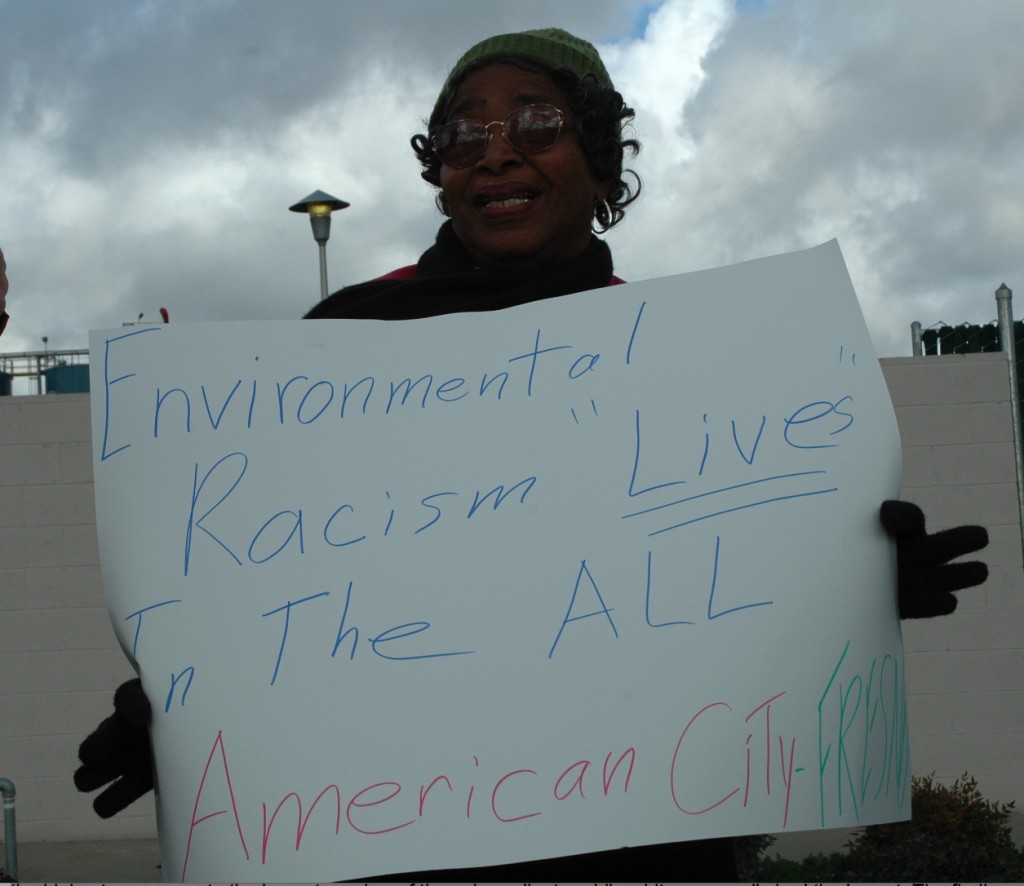 Yes. Or rather the forces that shape where pollution and people co-exist.
Yes. Or rather the forces that shape where pollution and people co-exist.
Historically we know that low-income and non-white urban areas are more likely to have polluting factories, Superfund Sites and illegal dumping. In large part, this is because the places within a city where "undesirable" heavy industries were allowed to locate were also traditionally also the only places where "undesirable" people, re: anybody that wasn't white or had a little money, were allowed to live. This is how you get massive segregated public housing complexes built across the street from huge lead smelters, as was the case in Dallas only a few decades ago. But maybe you thought that was all a thing of the past.
Today comes word of a new study out of Yale that confirms that people of color and the poor in the US suffer disproportionately from exposure to one of the most insidious kinds of pollutants – extremely tiny particles of poisonous soot called Particulate Matter 2.5 (that's soot that's 2.5 microns or less in size. A human hair is about 10 microns wide). Researchers looked at air monitoring and demographic data from five cities – Los Angeles, Pittsburgh, Cincinnati, St. Louis and Fresno. It is the first study to "reveal major racial and economic differences in exposures to specific particle ingredients, some of which are linked to asthma, cardiovascular problems and cancer." Not to mention strokes, and debilitating brain diseases like Parkinson's and Alzheimer's.
"Tiny particles of air pollution contain more hazardous ingredients in non-white and low-income communities than in affluent white ones, new research shows. The greater the concentration of Hispanics, Asians, African Americans or poor residents in an area, the more likely that potentially dangerous compounds such as vanadium, nitrates and zinc are in the mix of fine particles they breathe. Hispanics had the highest exposures to the largest number of these ingredients, while whites generally had the lowest. The findings of the Yale University study add to evidence of a widening racial and economic gap when it comes to air pollution. Communities of color and those with low education and high poverty and unemployment face potentially greater health risks even if their air quality meets federal health standards."
So how does that affect DFW? We need to let studies like this inform our decisions about city planning. In places that have a lot of pollution problems, it's probably a good idea not to keep adding more. Think of where the fracking in Dallas will be taking place – mostly in minority neighborhoods, along the floodplain, with other "undesirable" industries like landfills near-by. Think about the struggle over community control of the CF Hawn freeway re-do of Deadman's Curve in South Dallas where residents want fewer cars going slower instead of more cars going faster. Cars are a big source of PM pollution. Freeways are large conduits for PM pollution. In the last five years there's been a slew of studies showing more asthma and illness the closer you live to a major freeway. Guess which sub-populations get more freeways in their part of town?
There is an environmental equivalent of Affirmative Action that needs to be incorporated into city zoning and planning. One that considers the past historical inequities and current environmental body burden of affected neighborhoods. One that makes sure that society's "undesirables" do not keep getting piled on top of one another
EPA Interpretation of Soot Regs Under Fire
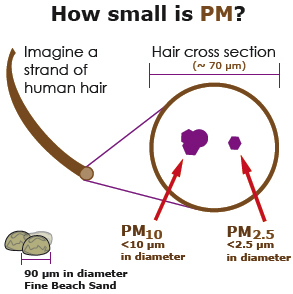 In an important challenge to the way EPA has gone about regulating the tiniest and most harmful forms of soot, or "Particulate Matter" pollution, attorneys for environmental groups seem to making some headway in the courts.
In an important challenge to the way EPA has gone about regulating the tiniest and most harmful forms of soot, or "Particulate Matter" pollution, attorneys for environmental groups seem to making some headway in the courts.
Currently, EPA is about to recommend new PM pollution rules that will reportedly lower the exposure standard for "PM 2.5" – that is, soot that's 2.5 MICRONS or less in size. A human hair is about 10 microns wide, so we're talking incredibly small particles that can easily find their way into your lungs, and then pass through directly into your blood stream.
However, when the Clean Air Act was amended in the early 1990's, the danger of PM pollution was confined to "PM 10" – particles 10 microns or less in size. So called "Coarse PM." But research over the last 20 years has pointed to the greatest danger to human health coming from the smallest kinds of PM pollution – the stuff that's 2.5 or smaller. It's been linked at very low levels of exposure not only to respiratory disease, but to heart attacks, strokes, and brain diseases similar to Parkinson's and Alzheimer's. In fact, the consensus among researchers now is that there is no level of exposure to PM 2.5 pollution that's not capable of doing some harm, that is, there is no "safe level" of exposure.
In another example of how regulations don't keep pace with science, EPA is still regulating PM 10 standards stricter than they are PM 2.5 standards, even though we now know that it's the smallest stuff that is more harmful. EPA is actually using another part of the Clean AIr Act to regualte PM 2.5 pollution than it uses to regulate PM 10 pollution. And the provision it uses for PM 2.5 allows states a lot more wiggle room than the tougher PM 10 provisions.
PM 10 pollution pouring out of a smokestack includes all PM 2. 5 pollution. But "PM 2.5 polluiton"excludes the larger coarser soot. Clear?
One of the three judges of the US Court of Appeals for the District of Columbia, David Tatel, had a hard time with the fact that EPA went outside it's own PM 10 rules to regulate a sub-set of more dangerous PM 10.
"I don't see why it makes much sense to separate out the fine particles," Tatel said. "I don't understand why the agency would do this.' Tatel indicated he did not believe the Clean Air Act required EPA to handle fine particulate matter differently than the coarser pollutants. References in the statute to PM 10 seemed to indicate Congress was referring to particulate matter in general, which would include PM 2.5, Tatel said."
This is exactly the argument EarthJustice lawyers were using. When the Clean Air Act says "fine particles" it means PM 10 and PM 2.5 – you can't regulate PM 10 without also regulating PM 2.5. But this is a law of physics that EPA is trying to undo. The Agency is actually arguing that Congress only meant to apply the standards to PM 10 pollution and no other "fine particles." It's also arguing that the challenge is a decade too late, since the original rules were passed in 1997. The judges didn't seem to be buying that defense either.
With brand new EPA regs for PM pollution expected to be announced shortly, one could reasonably assume this is mostly an academic exercise. but it's not. First, these old rules will still be in play for some time as the new ones are phased-in. It's important to get it right in the intervening period. These old regs affect PM emissions from cement kilns, boilers of all types, power plants and even cars and the public health impact of a stricter standard could be significant. Second, the interpretation EPA uses to establish the new rules could rest on whether the courts agree that it used the right provisions and language last time out.
We've been saying this a lot lately, but it's true. PM pollution is the most insidious, dangerous, and widespread form of air pollution in the world today. It is the ozone of the 21st Century in terms of how pervasive its effects are, and the size of the regulatory response to counter that harm.
Even a Few Weeks of Cleaner Air Can Make A Big Difference
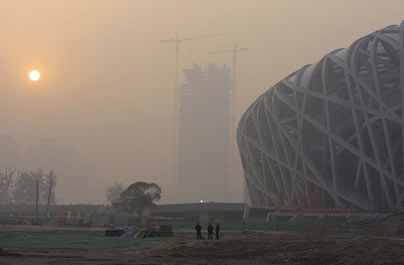 We can't tell you how many times a resident from DFW will go on a business trip or vacation to a less-polluted place and report an almost instant shedding of the ill effects of dirty air, only to have an almost equally fast re-acquaintance with those effects once they return. Could air pollution really make that much of a difference in so little a period of time?
We can't tell you how many times a resident from DFW will go on a business trip or vacation to a less-polluted place and report an almost instant shedding of the ill effects of dirty air, only to have an almost equally fast re-acquaintance with those effects once they return. Could air pollution really make that much of a difference in so little a period of time?
As it turns out, yes.
Via an new study recently published in the Journal of the American Medical Association, researchers found that the Chinese government's decision to close down Beijing's polluting factories and take cars off the road during the 2008 Olympics resulted in a remarkable short-term improvement in cardiovascular health. It's the first major study to look at the immediate effects of air pollution in young healthy adults.
In a synopsis published by Environmental Health News, one of the authors describes the study and its importance:
"For the 5-month study from June to November, the researchers recruited 125 resident doctors with an average age of 24 from a centrally located hospital. Half were male, and all were healthy with no history of diabetes or cardiovascular disease.
The researchers measured heart rate, blood pressure and six markers of cardiovascular diseases in blood samples before, during and after the games. The markers included C-reactive protein (CRP), fibrinogen, von Willebrand factor, soluble CD40 ligand, soluble P-selectin concentrations and white blood cell count (WBC).
Two markers associated with blood clotting significantly decreased from pre-Olympic to the during-Olympic period: P-selectin levels dropped by 34 percent and von Willebrand factor levels were reduced by 13 percent. After the games, when the pollution control measures were removed, most markers rose back to pregame levels. But two markers – P-selectin and systolic blood pressure – worsened and showed a significant increase compared to the levels during the games.
Air pollution emissions were also measured at similar times. Levels of most air pollutants during the games decreased up to 60 percent compared to their pregame levels, depending on the type of pollutants. For example PM2.5 dropped 27 percent, nitrogen dioxide 43 percent and sulphur dioxide 60 percent. After the games when pollution controls were removed, emissions rose to higher levels than were measured before the games started.
This study suggests that even young healthy people can benefit from short-term air pollution reduction and supports efforts to quantify and understand the benefits and costs of air pollution control measures."
The next time a politician complains about the cost of air pollution controls, make sure and ask them if they're for preventative heart disease treatment. When they say yes, please remind them that keeping crap out of our air that would otherwise end up in our lungs is such preventative care.
